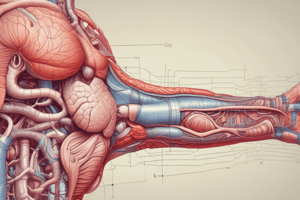Podcast
Questions and Answers
Which organ is involved in ingestion, chewing, and swallowing?
Which organ is involved in ingestion, chewing, and swallowing?
- The Stomach
- The Esophagus
- The Pharynx
- The Mouth (correct)
What do salivary glands secrete?
What do salivary glands secrete?
Saliva
The located under the tongue is called the ______.
The located under the tongue is called the ______.
Sublingual Salivary Gland
What is peristalsis?
What is peristalsis?
What connects the esophagus and small intestine?
What connects the esophagus and small intestine?
Which region of the stomach forms the upper medial wall?
Which region of the stomach forms the upper medial wall?
What is the role of sphincters in the stomach?
What is the role of sphincters in the stomach?
Which part of the digestive system is responsible for the absorption of nutrients?
Which part of the digestive system is responsible for the absorption of nutrients?
What is the primary function of the liver?
What is the primary function of the liver?
Which duct drains bile directly from the liver?
Which duct drains bile directly from the liver?
Flashcards are hidden until you start studying
Study Notes
Mouth
- Involved in ingestion, chewing, and swallowing; facilitates mechanical digestion.
- Teeth and tongue work together to break food into smaller pieces for easier digestion.
Salivary Glands
- Comprise three pairs that secrete saliva, carried to the mouth via ducts.
- Functions include dissolving food for taste, moistening food for swallowing, producing amylase for starch digestion, and cleaning the mouth.
Salivary Gland Types
- Parotid Salivary Gland: Located near the ear.
- Sublingual Salivary Gland: Positioned under the tongue.
- Submandibular Salivary Gland: Found under the jaw.
Pharynx
- Acts as a passage from the oral cavity to the esophagus; has two passageways: oropharynx and laryngopharynx.
- Coordinates swallowing through a three-stage reflex; peristalsis propels food into the esophagus.
Peristalsis
- A muscular squeezing motion that aids in moving food from the esophagus to the stomach.
Esophagus
- Muscular tube lined with mucous membrane situated behind the trachea, transporting food via peristalsis.
Stomach
- J-shaped pouch connecting the esophagus to the small intestine, located in the upper left abdomen.
- Highly acidic due to hydrochloric acid; features two curvatures: lesser and greater.
Curvatures of Stomach
- Lesser Curvature: Upper medial wall of the stomach.
- Greater Curvature: Lateral (lower) border of the stomach.
Stomach Anatomy
- Rugae: Folds that expand the stomach for food storage.
- Divided into four regions: Cardiac, Fundus, Body, and Pylorus.
Sphincters of Stomach
- Cardiac Sphincter: Prevents regurgitation from the stomach back into the esophagus.
- Pyloric Sphincter: Controls food entry into the small intestine and prevents backflow.
Functions of the Stomach
- Temporary storage for food; mechanical and chemical digestion; limited absorption; production of intrinsic factor for vitamin B12 absorption.
Small Intestine
- Extends from the stomach to the large intestine; primary site for digestion and absorption of nutrients.
- Mucosa features microvilli, goblet cells for mucus secretion, and endocrine glands for hormone secretion.
Sections of Small Intestine
- Divided into three parts: Duodenum, Jejunum, Ileum.
Digestion Process
- Completes in the small intestine with the help of enzymes produced by accessory organs (liver, pancreas, gallbladder).
- Specific enzymes break down proteins, carbohydrates, and fats; intestinal glands secrete hormones as well.
Absorption
- Major site for nutrient absorption in the body, occurring mainly in the small intestine.
Nutrient Requirements
- Essential nutrients include glucose, ions (K, Na, Cl), amino acids, water, vitamins/minerals, and fatty acids.
Large Intestine
- Also known as the colon; extends from the ileum to the anus; no digestion occurs here.
- Comprised of key sections: cecum (with appendix), colon (ascending, transverse, descending, sigmoid), rectum, and anus.
Ileocecal Valve
- Functions as a sphincter between the small and large intestines, preventing backflow of fecal material.
Main Functions of the Colon
- Absorbs water, minerals, and vitamins; supports bacteria producing essential vitamins; secretes mucus; eliminates indigestible materials.
Rectum and Anus
- Terminal sections of the digestive system; facilitates elimination of waste.
Accessory Organs of Digestive System
- Include the liver, gallbladder, and pancreas; essential for digestion and metabolism.
Liver
- The largest gland, located in the upper right abdomen; produces bile for lipid breakdown and processes nutrients from digestion.
- Responsible for metabolism, nutrient storage, detoxification, and bilirubin formation/excretion.
Gallbladder
- A pear-shaped sac that stores and concentrates bile from the liver until needed in the small intestine.
Pancreas
- Positioned across the posterior abdominal wall; performs both endocrine (insulin, glucagon) and exocrine (digestive enzymes) functions.
- Produces enzymes that digest carbohydrates, fats, and proteins; pancreatic juice helps neutralize stomach acid.
Duct System of Accessory Organs
- Hepatic Duct: Drains bile from the liver.
- Cystic Duct: Drains bile that is stored in the gallbladder.
- Common Bile Duct: Formed by the union of the hepatic and cystic ducts, empties into the duodenum.
- Pancreatic Duct: Carries pancreatic juice to the duodenum, essential for digestion.
Studying That Suits You
Use AI to generate personalized quizzes and flashcards to suit your learning preferences.




